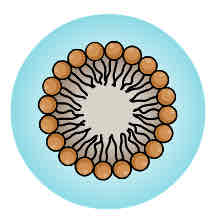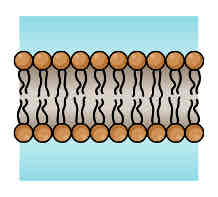transport across cell membranes
1/44
There's no tags or description
Looks like no tags are added yet.
Name | Mastery | Learn | Test | Matching | Spaced |
|---|
No study sessions yet.
45 Terms
rate of diffusion is proportional to:
(SA x difference in conc.) / membrane thickness
features of epithelial cells
1. microvilli → increases SA
2. large number of mitochondria → respiration to supply ATP for active transport
3. epithelium is one cell thick → short diffusion pathway
4. good blood supply → maintains a concentration gradient of glucose
the fluid-mosaic model of membrane
structure: phospholipid bilayer with glycoproteins (protein with carbohydrate attached), glycolipids (lipid with carbohydrate attached), cholesterol, peripheral membrane proteins, protein channels, integral membrane proteins
fluid: movement of phospholipid molecules relative to one another, flexible structure
mosaic: proteins embedded in the bilayer vary in shape, size and pattern like a mosaic
why is cholesterol present in cell membranes?
- a hydrophobic layer
- provides strength by reducing lateral movement of phospholipids
- prevents loss of water and ions from cells
- controls membrane fluidity (less fluid at high temperatures)
- more cholesterol → less fluid → less permeable → restricts movement
why are phospholipids present in cell membranes?
the polar nature of phospholipids allows them to interact with water
- phosphate group is polar and therefore hydrophilic (can interact with water)
- fatty acid chains are non-polar and therefore hydrophobic (can’t interact with water)
why are proteins present in cell membranes?
glycoproteins are carbohydrates bonded to proteins and carbohydrates are used for: cell communication, cell recognition, cell adhesion and binding sites for hormones or neurotransmitters
integral proteins help transport substances, such as ions, sugars and amino acids, that cannot diffuse across the membrane but are still vital to a cell’s functioning
other integral proteins are receptors for hormones and neurotransmitters, or enzymes for catalysing reactions
cell adhesion
cells attaching to one another

micelle

bilayer
membranes
plasma membranes: membranes around (and within) organelles
cell-surface membranes: membrane that surrounds the cell. provides different conditions and controls movement inside/outside the cell.
functions of cell and plasma membranes:
- keeps cell components inside the cell
- allows selected molecules to move in/out of the cell
- isolates organelles from cytoplasm - so cellular processes can occur separately
- site of biochemical reactions
permeability of the membrane
- the role of the phospholipids is to act as a barrier, and control which substances/molecules enter or exit the cell/organelle
- semi-permeable
- small non-polar molecules can diffuse rapidly across the membrane
- small polar molecules can diffuse across the membrane, but at a slower rate
- ions can’t freely diffuse as they have a charge
- large molecules can’t freely diffuse as they’re too big
cholesterol
- a type of lipid
- hydrophobic
integral (or intrinsic/transmembrane) proteins
- span the whole width of the membrane
- many are carrier molecules or channels
peripheral (or extrinsic) proteins
- are confined to the inner or outer surface of the membrane
- may be free on the membrane surface or bound to an integral protein
- two types of peripheral proteins:
→ extracellular: receptors for hormones or neurotransmitter, or are involved in cell recognition. many are glycoproteins.
→ intracellular: on the cytosolic side of the membrane and are involved in cell signalling or chemical reactions. they can dissociate from the membrane and move into the cytoplasm.
what is a fluid membrane necessary for?
- diffusion of substances through the membrane
- allows membranes to fuse with vesicles during exocytosis
- cells move and change shape e.g. macrophages during phagocytosis
simple diffusion
- the net movement of small, non-polar molecules from a region of high conc to lower conc, down a concentration gradient, until they’re evenly distributed
- a form of passive transport as no metabolic energy is required
what is facilitated diffusion?
- large molecules or ions require a protein to diffuse across a membrane
- passive process
- net movement from high to low conc, down a conc gradient
- protein channels or carrier proteins
protein channels
movement of ions, they are specific (open/closed in response to messengers or change in voltage)
carrier proteins
have binding sites for larger molecules (amino acids or glucose), cause a change in tertiary structure allowing the molecule to pass through
what affects the rate of diffusion?
- the greater the surface area, the faster the rate of diffusion
- the greater the difference in conc, the quicker the rate of diffusion
- the higher the temp, more kinetic energy particles will have, so they’ll move and mix more quickly
what is osmosis?
- the net movement of water from a high to low water potential, down a WP gradient, through a selectively permeable membrane
- passive process
solute
the minor component in a solution, dissolved in the solvent
water potential
- the pressure created by water molecules
- measured in kilopascals (kPa)
solution
a liquid mixture in which the solute is uniformly distributed within the solvent
solvent
the major component in a solution
how does osmosis affect animal cells?
can cause cells to burst, therefore, cells are found in liquid with an equal water potential
hypertonic solution
- water diffuses out of cell via osmosis from high to low water potential
- could cause cell to shrink and shrivel
isotonic solution
water potential inside cell = water potential outside cell
hypotonic solution
- water diffuses into cell via osmosis from high to low water potential
- could lead to cell bursting
how does osmosis affect plant cells?
unlike animal cells, plant cells are unable to control the composition of the fluid around their cells
- turgid → vacuole has become swollen and pushes the cell contents against the cell wall
- flaccid → no change to cell due to equal water concentrations
- plasmolyzed → the vacuole has shrunk and cytoplasm has come away from cell wall due to loss of water
active transport
- movement of molecules from low to high concentration, against their conc gradient
- active process
- requires energy from the hydrolysis of ATP
- requires a carrier protein
how could cells be adapted for rapid transport across their internal or external membranes?
- large surface area
- large number of protein channels and carriers in their membranes
co-transport
transport of one substance is coupled with the transport of another substance across a membrane
how does oral rehydration therapy work?
- optimises the absorption of fluid in the intestines, which helps quickly replenish fluids
- made of water, glucose, sodium and potassium
- used to treat moderate dehydration
co-transport in the ileum
- in co-transport glucose/amino acids are drawn into the cells along with Na+
- Na+ actively transported into blood
- this creates a concentration gradient
- Na+ conc in epithelial cells decreases
- facilitated diffusion of Na+ from ileum into cells - along with glucose/amino acids - co-transport
- facilitated diffusion of glucose/amino acids into blood
what is endocytosis?
the bulk intake of material by a cell by the formation of vesicle
what is exocytosis?
the process by which a cell secretes waste material and other substances
what are the three main factors that affect the fluidity of cell membranes?
temperature
lipids
cholesterol
colorimeter
- the clearer the solution, the lower the absorbance of light (AU)
- the clearer the solution, the higher the transmission of light (%)
calibration curves
- the purpose of a calibration curve is to plot known concentrations of glucose against absorbance of light
- they can then be used to find out the glucose concentration of an unknown sample, using the known absorbance of light
The movement of Na+ out of the cell allows the absorption of glucose into the cell lining the ileum. Explain how.
1. maintains a concentration gradient for Na+ from ileum into cell
2. Na+ moving in by co-transport, brings glucose with it
The movement of substances across cell membranes is affected by membrane structure. Describe how.
1. phospholipid bilayer allows diffusion of non-polar substances
2. carrier proteins allow active transport
3. carrier proteins allow co-transport
4. shape of carrier determines which substances move
5. number of carriers determines how much movement
6. membrane SA determines how much diffusion
Give two similarities in the movement of substances by diffusion and by osmosis.
1. movement from high concentration to low concentration
2. passive process
Describe a method the student could have used to monitor the temp of the water in each tube.
take readings during the experiment using a digital thermometer
high absorption of salt from the diet can result in a higher than normal conc of salt in the blood plasma entering capillaries. this can lead to a build-up of tissue fluid. explain how.
1. higher salt results in lower water potential of tissue fluid;
2. so less water returns to capillary by osmosis at venule end;